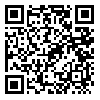Volume 28, Issue 111 (11-2019)
JGUMS 2019, 28(111): 13-29 |
Back to browse issues page
Download citation:
BibTeX | RIS | EndNote | Medlars | ProCite | Reference Manager | RefWorks
Send citation to:



BibTeX | RIS | EndNote | Medlars | ProCite | Reference Manager | RefWorks
Send citation to:
Ebrahimi Hosseinzadeh B, Hatamian Zarmi A, Babapour F, Farhangian A, Barshan Tashnizi M, Nojoki F. Investigating the Antibacterial Property of Silver Nanoparticles in Alginate Wound Dressings. JGUMS 2019; 28 (111) :13-29
URL: http://journal.gums.ac.ir/article-1-2192-en.html
URL: http://journal.gums.ac.ir/article-1-2192-en.html
B Ebrahimi Hosseinzadeh *1 

 , A Hatamian Zarmi
, A Hatamian Zarmi 

 , F Babapour
, F Babapour 

 , A Farhangian
, A Farhangian 

 , M Barshan Tashnizi
, M Barshan Tashnizi 

 , F Nojoki
, F Nojoki 




 , A Hatamian Zarmi
, A Hatamian Zarmi 

 , F Babapour
, F Babapour 

 , A Farhangian
, A Farhangian 

 , M Barshan Tashnizi
, M Barshan Tashnizi 

 , F Nojoki
, F Nojoki 


Abstract: (2899 Views)
Abstract
Introduction: Nanosilver is a nanotechnology product with antimicrobial property. It can improve efficiency, reduce cost and increase antimicrobial durability and performance of wound dressing.
Objective: This research intended to introduce a dressing that accelerated and improved the wound healing process by keeping the wound area moist and simultaneously prevented colonization by microorganisms and wound infection.
Materials and Methods: Silver nanoparticles were trapped in the pores of calcium alginate sheets, and particle loading on films took place. When this dressing is put on a wound, the silver ions are released in the wound area. After loading the silver nanoparticles; their presence in the calcium alginate structure was confirmed by FE-SEM micrographs. Wounds (2 × 2 cm2) were made on rats’ bodies and images were taken of the wound healing process on the 1st, 7th, and 14th days to study the effect of the dressing on tissues of living organisms.
Results: Characterization of silver nanoparticles was carried out by the DLS test and Zeta potential measurement, in which the values of 61.4 nm and -20.83 mV were obtained, respectively. Antibacterial properties were studied and cell toxicity tests were performed to determine the suitable concentration. Results indicate that the optimum concentration was 100μg/l (or 17.5μg per unit area of the alginate film). Using the ImageJ software, the surface areas of the wounds were calculated, and histological studies were also conducted on wound healing. Moreover, on the 7th and 14th days, samples were taken of them to carry out histopathological investigations, and changes in skin cell shape were studied.
Conclusion: The results of this study suggestthat the dressing accelerates simultaneously the process of wound healing and prevents wound infection and postponement of its repair.
Conflict of interest: non declared
Introduction: Nanosilver is a nanotechnology product with antimicrobial property. It can improve efficiency, reduce cost and increase antimicrobial durability and performance of wound dressing.
Objective: This research intended to introduce a dressing that accelerated and improved the wound healing process by keeping the wound area moist and simultaneously prevented colonization by microorganisms and wound infection.
Materials and Methods: Silver nanoparticles were trapped in the pores of calcium alginate sheets, and particle loading on films took place. When this dressing is put on a wound, the silver ions are released in the wound area. After loading the silver nanoparticles; their presence in the calcium alginate structure was confirmed by FE-SEM micrographs. Wounds (2 × 2 cm2) were made on rats’ bodies and images were taken of the wound healing process on the 1st, 7th, and 14th days to study the effect of the dressing on tissues of living organisms.
Results: Characterization of silver nanoparticles was carried out by the DLS test and Zeta potential measurement, in which the values of 61.4 nm and -20.83 mV were obtained, respectively. Antibacterial properties were studied and cell toxicity tests were performed to determine the suitable concentration. Results indicate that the optimum concentration was 100μg/l (or 17.5μg per unit area of the alginate film). Using the ImageJ software, the surface areas of the wounds were calculated, and histological studies were also conducted on wound healing. Moreover, on the 7th and 14th days, samples were taken of them to carry out histopathological investigations, and changes in skin cell shape were studied.
Conclusion: The results of this study suggestthat the dressing accelerates simultaneously the process of wound healing and prevents wound infection and postponement of its repair.
Conflict of interest: non declared
Keywords: Alginates Dressings Nanoparticles
Review Paper: Research |
Subject:
Special
Received: 2019/11/16 | Accepted: 2019/11/16 | Published: 2019/11/16
Received: 2019/11/16 | Accepted: 2019/11/16 | Published: 2019/11/16
| Rights and permissions | |
 |
This work is licensed under a Creative Commons Attribution-NonCommercial 4.0 International License. |




